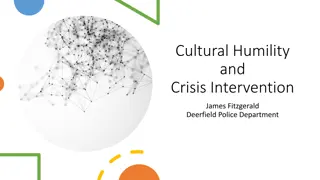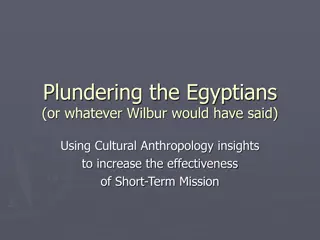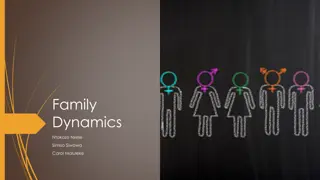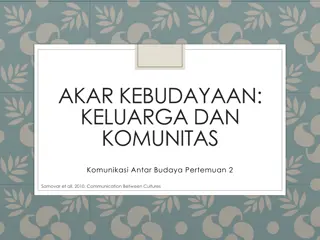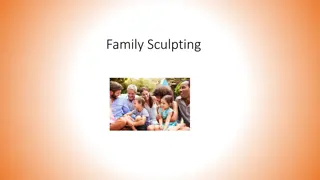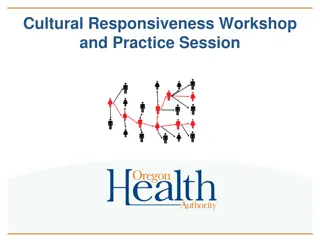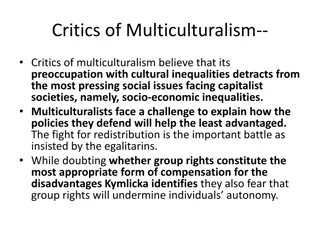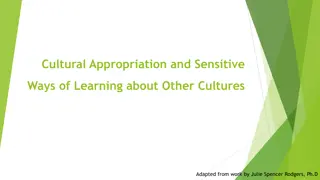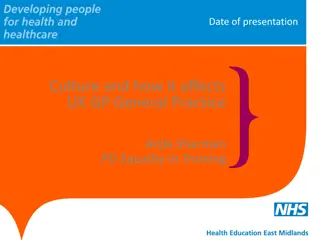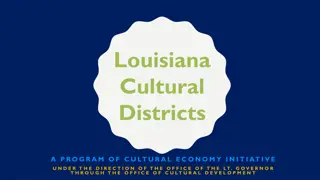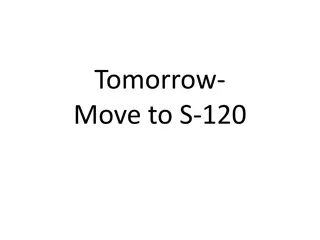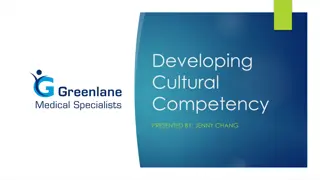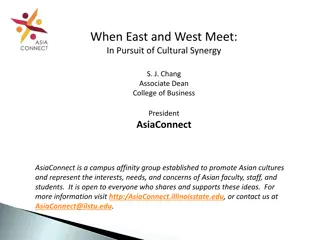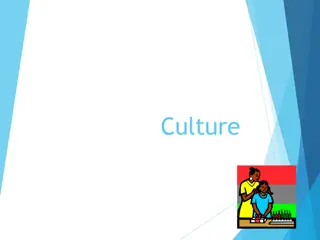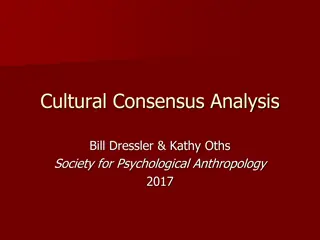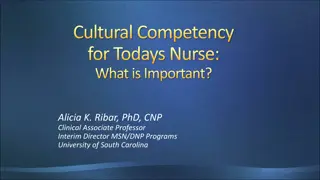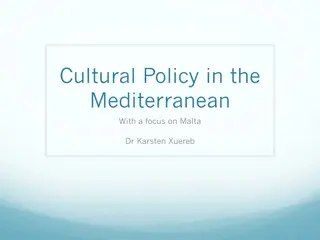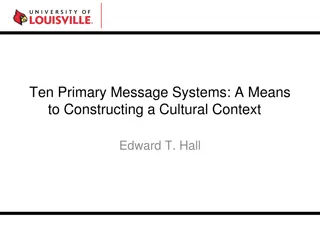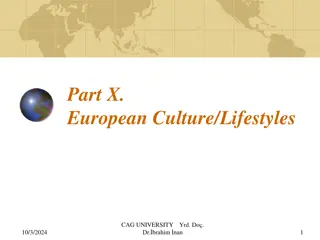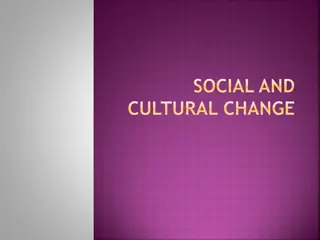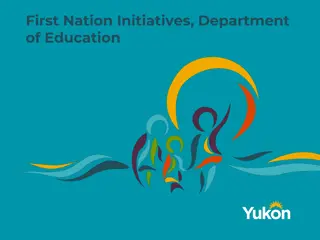Understanding Family Dynamics through Genograms in a Cultural Context
Family systems are complex and interconnected, with roles, rules, and patterns that shape their functioning. Genograms offer a practical framework for mapping family structures, relationships, and histories over generations, aiding practitioners in identifying patterns and connections. Cultural genograms enhance cultural awareness and sensitivity by capturing diverse stories beyond genealogy, promoting curiosity and understanding of social differences and similarities. This comprehensive approach helps practitioners support families systemically and culturally.
Download Presentation

Please find below an Image/Link to download the presentation.
The content on the website is provided AS IS for your information and personal use only. It may not be sold, licensed, or shared on other websites without obtaining consent from the author. Download presentation by click this link. If you encounter any issues during the download, it is possible that the publisher has removed the file from their server.
E N D
Presentation Transcript
Genogram/ Cultural Genogram Genogram/ Cultural Genogram Lydie Cacoujat Clinical Lead Systemic Practice Lead 06/09/22
How do you define a family? Systemic Perspective A family is a system as it is composed of different parts who are connected, that system as rules, boundaries, people have roles and those create patterns that enable it to function. A change in one part of the system will be experienced in other parts of the system. A family consists of the entire kinship network of at least three generations, both as it currently exists and it has evolved through times. Those who are tied together through their common biological ,legal, cultural and emotional history and by their implied future together ( Carter & McGoldrick 2005).
Historical Development The term family diagram was proposed by Dr Murray Bowen sometime before 1978. The family diagram generally replaced hard to read written material. It went far beyond ordinary genealogy to include items considered essential by the theory. Later the family diagram was misinterpreted as being synonymous with genealogy and was incorrectly called genogram (Kerr, M & Bowen, M., 1998, p. 374) In 1985 a study published by McGoldrick and Garson standardised all the symbols which are still used today.
Genograms: Mapping Family Systems Genograms has been established as a practical framework for understanding family systems. record information about family members and their relationships over at least 3 generations. allow you to map the family structure clearly and to note and update the map of the family patterns of relationships and functioning. make it easier for practitioner to keep in mind the complexity of a family s context, including family history, patterns and events that may have ongoing significance for the family. Help practitioner to think systemically about how events and relationships in the lives of the family they are supporting are related to the patterns of health and illness, safeguarding concerns
Cultural Genogram promotes cultural awareness and sensitivity. In addition to pay attention to our own stories- to take a reflexive position (Hardy and Laszloffy ( 1995) This is a tool that captures more than the story of who is who but also captures stories of culture, class, education, sexuality, etc. etc. etc. The Falicov (1995) paper challenges us to have an attitude of interest - be curious This fits well with our new practice model relational social work / cultural competency LBWF is multicultural and this is represented within its workforce
Social Graces: Social GGRRAAACCEEESSS (SG) is an acronym by Burnham and Hall- SG stands for the aspects of a person s identity. *facilitating thinking, curiosity about the influences of social differences/power /similarities and differences * promote self reflexivity *aspects of SG are interwoven, in flux and moving, with aspects coming to the foreground or going into the background * in/visible- un/voiced
Genogram as a visual tool- Different meanings in different contexts A Genogram is used an assessment tool- gathering information- paying attention to relationships within the family and wider social network( school, church etc..) A Genogram is used as an intervention tool Explore family scripts / intergenerational stories of trauma Promote cultural awareness and sensitivity culturally competent social workers Helpful for safety planning exploitation, Gang
Gathering family information and construction of the genogram should be part of a general process of joining assessing and helping a family. Interviewing family approach The genograms tell the family story ( ies) what is the story ( ies) they are choosing to share . In context of an assessment - Creating Genograms Information gathered should be done with purpose and this needs to be explained to the family and with respect. What relationship do you have with the family? What is the practitioner emotional posture? In context of social care When is the right time to do a genogram How do I ask questions and what questions?
Emotional Postures preparing ourselves for entering a relationship/ readiness to start the work Glenda Fredman( 2007) Posture of mobilisation- Defensive, ready for action, vigilant of threat, ready to defend. Posture of tranquillity- Actively listening, being curious, creating and reflecting. How do you to attend to your own Emotional Posture ? How do you able to attend to the Emotional Posture of the family member/s you were working with?
Emotional postures and Embodiment Emotional postures and Embodiment Emotional Postures Embodiment Thinking about the families emotional posture, how might you support the family when drawing a genogram ? Thinking about your own embodiment, how can you support the family when drawing a genogram?
Understanding current and historical context of the family Family repeat themselves. What happens in one generation will often repeat it self in the next- the same issues tend to be played out from generation to generation , though the actual behaviour may take a variety of forms- Bowen Multigenerational transmission of family patterns ( family scripts). The hypothesis is that relationship patterns in previous generations may provide implicit models for family functioning in the next generation. On the genogram , we explore patterns of functioning , relationship and structure that continue or alternate from one generation to the next.
Mapping the family structure The drawing needs to confirm certain rules so that all practitioners have the same understanding of the genogram language The map is the construction of squares, circles and triangles representing people and lines delineating their relationships. Demographic information - getting the facts- use of social graces They are not limited to family members, friends, religious leaders, animals etc. are often added
Genogram Symbols
Genogram relationships Keys: Symbols- descriptions
Missing information Information is always missing from genograms but what information is missing in itself may give clues to family secrets, cutoffs and so on. Or sometimes the family do not have that information eg slavery, being adopted
Tracking family patterns It may be useful to create different genograms to show different kinds of information, perhaps one for basic demographics, one ofr relationship patterns, one for patterns of the family creativity and dysfunction , one for the family s community connections , and to provide snapshots of key points in the family s history.
Relationship questions There are many relationship questions you may want to ask to beging to get an understanding of the family such as: Are they family members that are close/distant? Who helps out when help is needed? In whom do family members confide? Is someone missing in the genogram that you consider family but they are not blood related? Is someone missing in this genogram that you do not want to mention / be in the genogram?
Discussions 1) Reflections( 3mins) - the group to listen and to pay attention to their own resonances. Karen and Lydie to reflect on theory. To make connection to social work practice What are the resonances for Karen ? 2) Group to reflect on Karen and Lydie s reflection 3mins
Activity Personal Genogram Choose a partner to work with for the whole session. This exercise is to be done in two halves, EACH having an 20-25mins. Draw your genogram-Focusing on your family of origin. 1. 3 generations (if poss.) 2. Identify different cultures Get as much detail down as you feel able to
Activity- QUESTIONS TO CONSIDER What were the stories told about change in your family of origin? What were the migration patterns? How were the gender roles defined? What significance does race, skin colour and hair play within the family? What were the negative & positive stories around beliefs and values i.e. education, money, sex, marriage, race, class, disability etc? What were the issues of conflict that divided members in your family? A) What prejudices does your family have about itself? B) What prejudices do/did other families have about your family? C) What prejudices do/did your family have about other families?
Questions to the group TO END What is the significance of your family stories on you as a practitioner? (Do this in the pairs and then use it as part of the whole gr)oup discussion) Self care - can contact me after the workshop if needed
References John Burnham, (2005), Relational reflexivity: a tool for socially constructing therapeutic relationships: The Space Between: Experience, Context, and Process in the Therapeutic Relationship: Karnac, 1-17 John Byng-Hall, (1995), Creating a secure family base: Some implications of attachment theory for family therapy: Family Process, Vol. 34, 45-58 John Byng-Hall (1995) Chapter 1 secure enough to improvise, in Rewriting Family Scripts: Improvisation and Systems Change, Guildford Press New York Kenneth Hardy & Tracey Laszloffy (1995) The Cultural Genogram: Key to Training Culturally Competent Family Therapists, Journal of Marital and Family Therapy, Vol 21, No 3, 227-237 (not given out in 2010) Russell Haber, (1994), Response-ability: therapist s I and role: Journal of Family Therapy, 16, 269-284 Inga-Britt Krause (2002) Culture and System in Family Therapy: Karnac, London, New York Barry Mason, (1993), Towards positions of safe uncertainty: Human Systems: The Journal of Systemic Consultation and Management, Vol. 4, 189-200 McGoldrick, M., Gerson. (1985) Genograms in Family Assessment, New York, Norton & Co. McGoldrick, M., Gerson, R., Shellenberger, S. (1999) GENOGRAMS-Assessment and Intervention (2nd Ed) W.W. Norton & Company, New York, London


